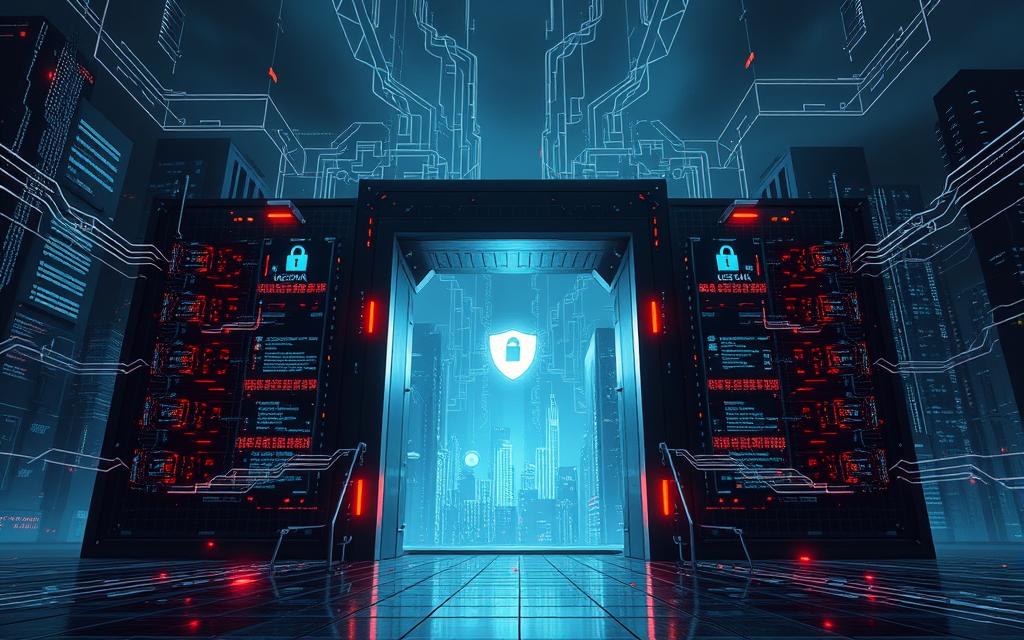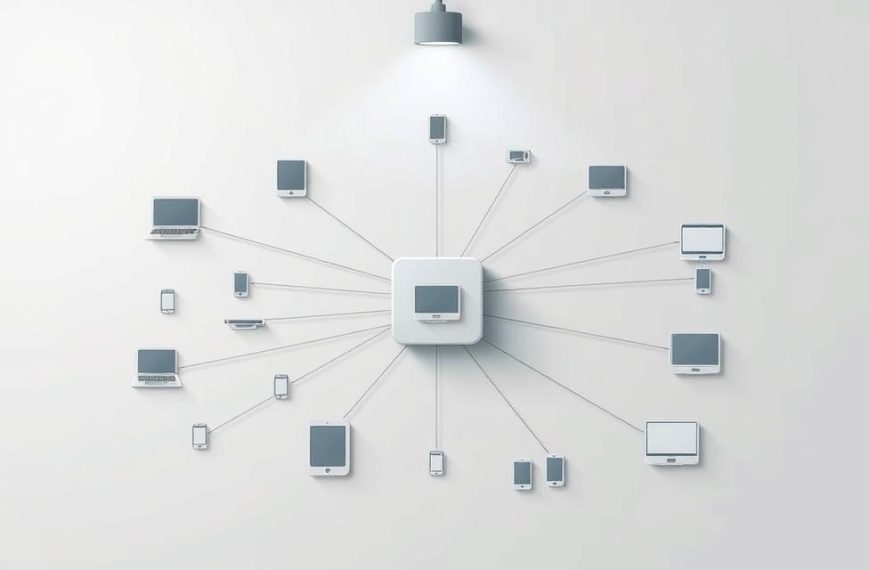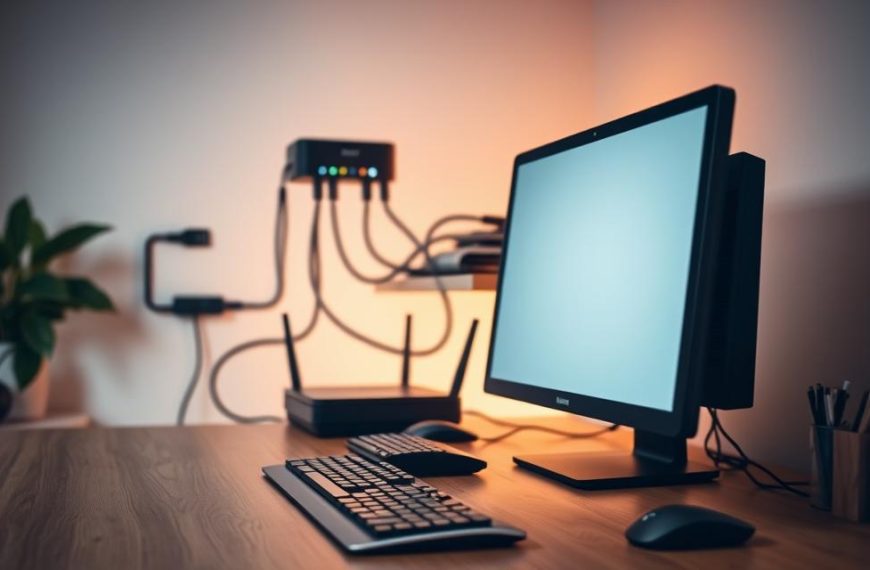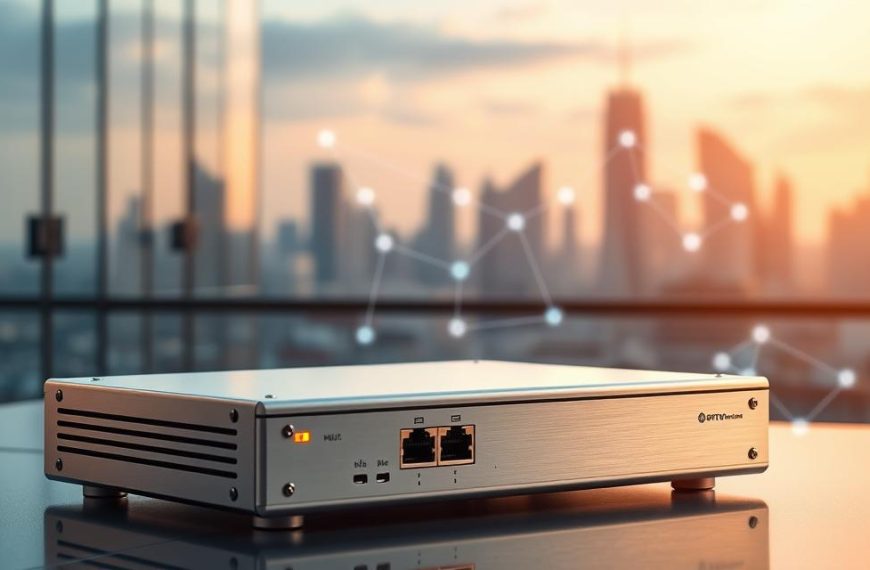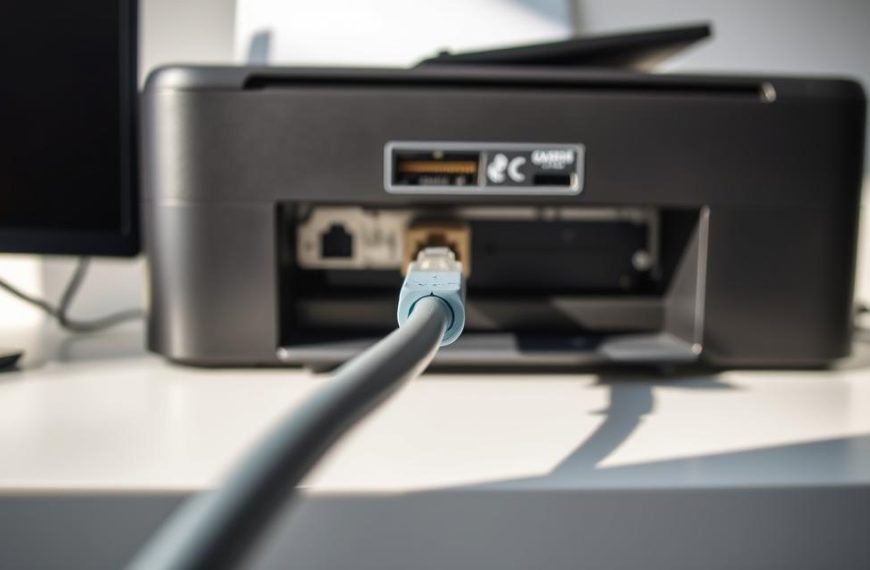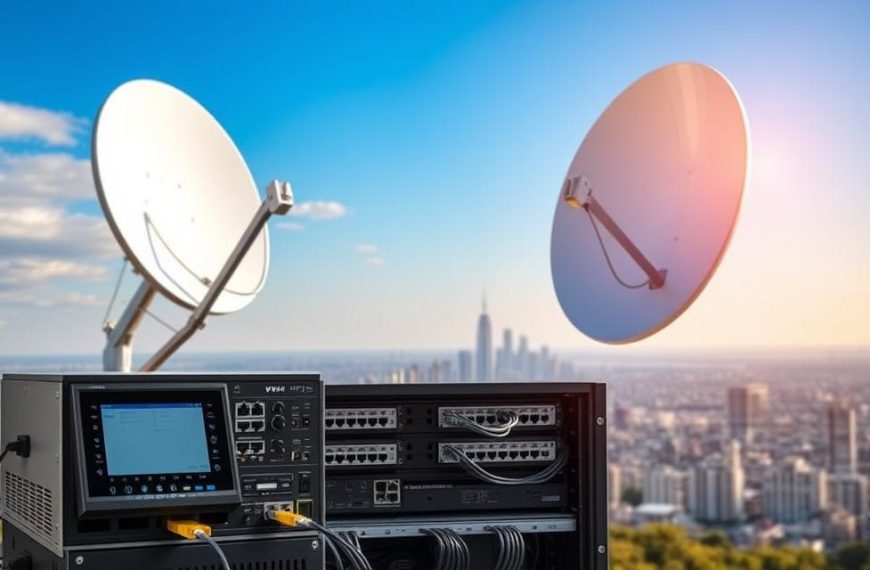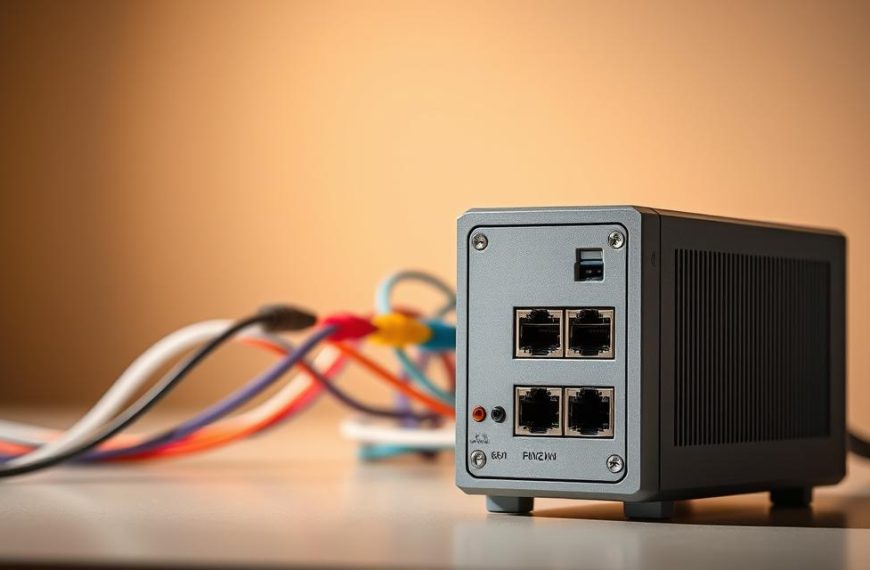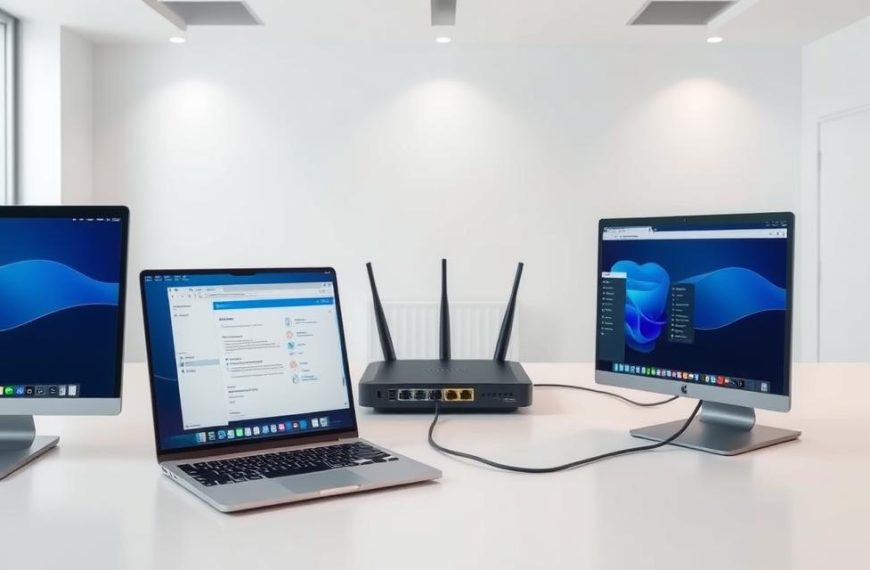Imagine a vigilant security guard at your network’s entrance, checking every digital traffic piece. This guardian is key to modern network security, keeping your systems safe from threats.
This digital sentry acts as a protective barrier between trusted internal networks and external sources. It carefully checks both incoming and outgoing data packets against security protocols.
The main goal is to stop unauthorised access while letting through legitimate communications. This makes it a vital part of strong cybersecurity plans.
By constantly monitoring and filtering, this system gives basic digital protection to both organisations and individuals. It’s the first defence in our digital world.
What is a Firewall in a Computer Network?
A firewall is like a shield that protects your network from the outside world. It checks all data trying to get in or out. This helps keep your digital stuff safe.
Defining the Firewall and Its Primary Role
A firewall definition is about its role as a network guard. It watches and controls the traffic going in and out. It uses security rules to decide what data packets can pass through and what to block.
The main job is to inspect each data packet carefully. It looks at things like:
- Source and destination IP addresses
- Communication protocols being used
- Port numbers associated with the traffic
- Content patterns within the data
This careful check makes sure only safe communications get through. It stops harmful data from getting into your network.
The Evolution of Firewall Technology
The history of firewalls is quite interesting. It shows how they’ve changed to keep up with new threats. Early firewalls just looked at packet headers and followed simple rules.
As networks got more complex, firewalls got smarter. They started to track connections and make better decisions about traffic.
Then, they evolved to understand specific protocols and services. Now, we have next-generation firewalls. They do deep packet inspection, prevent intrusions, and use advanced threat intelligence.
| Era | Firewall Type | Key Capabilities | Limitations |
|---|---|---|---|
| 1980s-1990s | Packet Filtering | Basic rule-based filtering | No connection state tracking |
| 1990s-2000s | Stateful Inspection | Connection state awareness | Limited application awareness |
| 2000s-2010s | Application Layer | Protocol-specific filtering | Performance impact concerns |
| 2010s-Present | Next-Generation | Integrated threat prevention | Complex configuration requirements |
This shows how firewalls have grown to meet new security needs. They’ve kept networks safe while also keeping them running smoothly.
The Critical Importance of Firewalls for Digital Security
Without firewalls, your digital security is like leaving your front door open in a dangerous area. Firewalls act as guards, checking all network traffic against set rules. They are key to keeping your digital world safe.
Shielding Against Unauthorised Intrusions
Firewalls stop hackers from getting into your network. They do this by looking closely at each piece of data coming in or out. This way, only safe traffic gets through.
They act like a digital guardhouse, checking all communications. Any unwanted attempts are blocked, keeping your network safe from cyber attacks. This is very important for places that handle sensitive data.
Today’s firewalls use advanced methods like:
- Deep packet inspection for detailed traffic checks
- Real-time threat updates
- Behavioural analysis to spot odd patterns
- Quick response to threats
Combating Malware and Data Breaches
Firewalls do more than just block access. They also fight off malware and prevent data breaches. They stop bad communication with hackers, helping keep your data safe.
They can spot and block suspicious data, helping to stop cyber attacks. This extra layer of security works well with other safety tools. Together, they make your network much safer.
But remember, firewalls are just part of a bigger security plan. You also need:
- Security training for everyone
- Up-to-date antivirus and anti-malware
- Regular software updates
- Good backup and recovery plans
When set up right, firewalls are vital for protecting against online threats. They play a big part in keeping your digital world safe from harm.
Different Types of Firewalls and How They Function
Firewall technology has grown into many types, each with its own way of protecting. Knowing about these types helps organisations pick the best defence for their needs.
Hardware Firewalls: Network-Level Protection
Hardware firewalls are physical devices at your network’s edge. They check all traffic before it hits your devices.
They offer strong protection for networks without slowing down devices. Many use stateful inspection to keep an eye on connections for better security.
Businesses often use hardware firewalls as their main defence. They block unwanted access before it reaches the network.
Software Firewalls: Host-Based Defences
Software firewalls sit on computers or servers. They offer custom protection for each device.
These apps watch traffic at the app level, giving detailed control over what can talk to what. They’re great at stopping malware from sending out data.
Choosing between hardware vs software firewall depends on what you need to protect. Software is best for individual devices in secure networks.
Next-Generation Firewalls: Advanced Security Features
Next-Generation Firewalls (NGFWs) are the latest in network security. They mix traditional firewall features with new ones.
Modern NGFW systems do deep packet inspection, looking at content, not just headers. This catches threats that old firewalls might miss.
Many NGFWs have intrusion prevention and know about applications. Some are even UTM devices, combining many security functions.
These systems often act as proxy firewalls, hiding users from the internet. This adds more privacy and content control.
Big NGFW solutions have central management tools. This lets security teams keep policies the same everywhere.
How Firewalls Work to Safeguard Your Network
Firewalls check data packets on a network. They use rules to decide if communications are allowed or blocked. These rules have grown more complex, giving different levels of protection.
Packet Filtering: The Foundation of Firewall Operations
Packet filtering is the basic firewall security method. It looks at data packets’ header info like IP addresses and port numbers. The firewall then decides if to allow or block based on these details.
This first layer of packet analysis offers basic protection. Stateless firewalls use this method, treating each packet alone. While good for simple tasks, it’s not enough for complex threats.
Stateful Inspection: Tracking Connection States
Stateful inspection is a big step up in firewall tech. Unlike basic filtering, these firewalls keep track of active connections. They understand the whole communication session, not just single packets.
This connection tracking lets firewalls make smarter choices. They can spot established connections and related packets. This reduces false alarms and boosts security. Stateful firewalls use a table of active connections for all packet checks.
Application-Level Monitoring: Granular Control
Application-level monitoring, through deep packet inspection, offers the most detailed security. It looks at packet headers and data content. This lets firewalls identify specific apps, services, or content types.
Next-gen firewalls use this to control apps in detail. They block threats by identifying apps, not just ports. This stops modern threats while letting business tools work. You can learn more about preventing unauthorised app use here.
Combining these methods gives a strong security setup. Modern firewalls use many techniques. They adapt to new threats and needs.
Choosing and Configuring an Effective Firewall Solution
Choosing the right firewall needs careful thought. It affects your network’s security and how well it works. Think about what you need before making a decision.
First, understand what your organisation needs. Look at your network size, how traffic moves, and what security you want. This helps pick a firewall that fits your needs.
Key Considerations for Selection
When looking at firewalls, consider a few key things. Make sure the firewall balances security with network performance. This avoids slowing down your network.
Scalability is also important. Your firewall should grow with your network without needing a new one. Think about if you need advanced features like deep packet inspection.
How easy it is to manage the firewall matters too. Some like centralised management, while others prefer simple solutions. Your budget will also play a part, but don’t cut corners on security.
It’s important that the firewall fits with your current network. Look at vendor support and how often they update their products. This ensures your firewall stays effective over time.
“Selecting the right firewall requires careful consideration of such factors as the required level of security, network performance, scalability, and ease of management.”
Optimal Configuration Practices
Setting up your firewall right is key. Start with a clear security policy. This defines what traffic is allowed and what’s blocked.
Use the least privilege principle when setting up rules. Only allow necessary traffic and block the rest by default. This reduces attack risks.
Regularly review and update your firewall rules. Clean out old rules every quarter. Keep records of any changes for audits and troubleshooting.
Keeping your firewall up to date is essential. Apply patches quickly to fix vulnerabilities. Update during maintenance to avoid disruptions.
Watch your logs for unusual activity. Set up alerts for odd traffic or repeated login attempts. Regular audits help keep your security policy in check.
| Configuration Aspect | Best Practice | Frequency | Tools |
|---|---|---|---|
| Rule Review | Remove obsolete rules | Quarterly | Firewall console |
| Software Updates | Apply security patches | Monthly | Vendor portal |
| Log Analysis | Monitor for anomalies | Daily | SIEM systems |
| Backup Configuration | Maintain restore points | Weekly | Configuration management tools |
Windows Defender Firewall shows how to manage your firewall well. It lets you control traffic in detail while keeping your system running smoothly.
For Linux, iptables is a powerful tool for managing rules. It works through the command line. Both examples show how to set up a strong security policy.
Remember, firewall setup isn’t a one-time job. Update your settings as your network and security needs change. Regular tests help ensure your setup works as planned.
Conclusion
A firewall is a key part of keeping digital spaces safe. It blocks unwanted access and fights off cyber threats. Firewalls have grown from simple packet filtering to advanced next-gen tools.
Good cybersecurity needs a layered approach. Firewalls are a vital first defence, but they work best with other security steps. This mix of measures creates a strong shield against many threats. It’s not just about tech; education and policies are also important.
This summary shows firewalls are essential for digital safety. They watch traffic, stop threats, and keep networks safe. Everyone should make firewalls a top priority. A well-set-up firewall is the base for strong digital safety in our connected world.

